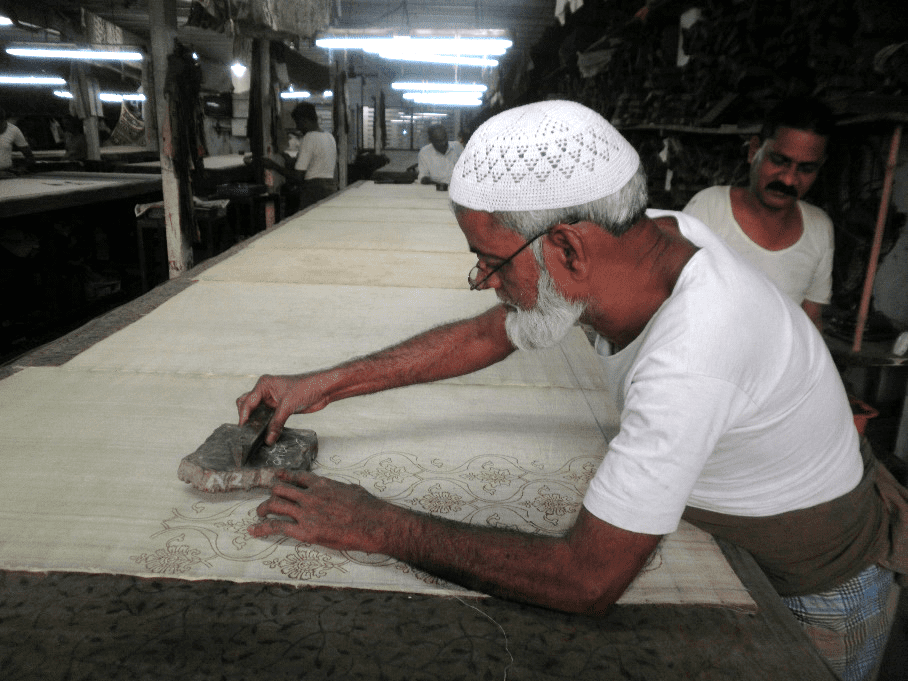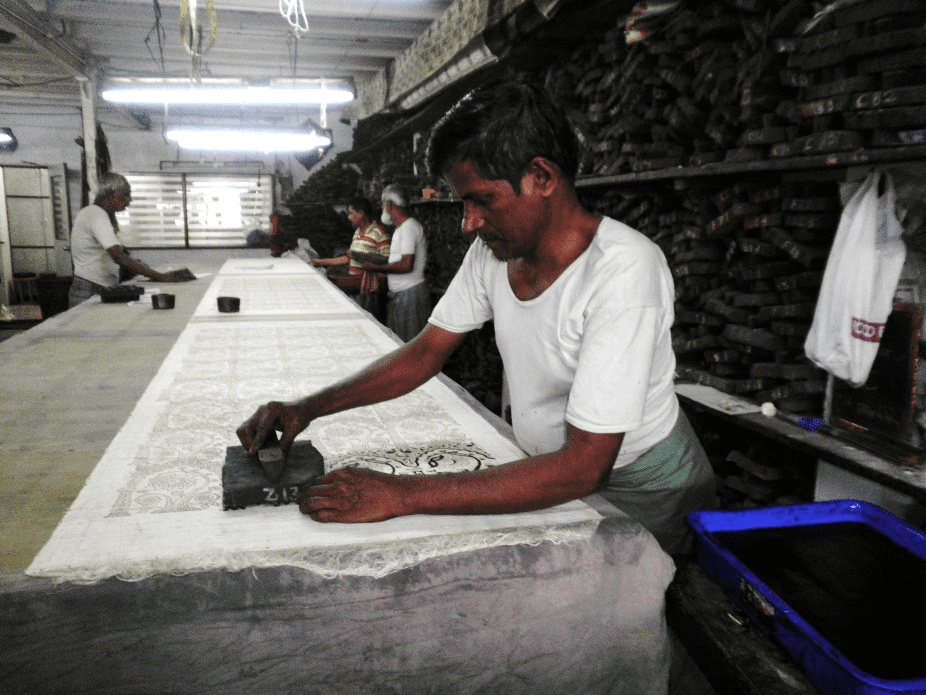Millions of individuals in Mumbai’s hustling metropolis are attempting to realize their ambitions and achieve something exceptional only for the sake of gaining recognition from the rest of the world. Among those millions of people, today we will present that one in a million who is working for a cause rather than for mere applause.
It was just another day in Damar Galli on Mohammad Ali Road, one of Mumbai’s busiest roads. We made our way through the crowds and chaos to the city’s crown jewel. Nobody believes that these busy lanes are home to India’s textile legacy.
Mr. Sarfraz greeted us with a bright grin and directed us to the treasure that awaited us. There were massive tables with cloth draped over them, as well as the countless blocks stacked against the walls. His workshop is rarely this quiet. “We are unable to function as we used to because to the pandemic,” he explained.
 On typical days, his artisans, who have been working with him for decades, would be occupying all of those large tables, producing the rhythmic sound of intricately carved wooden blocks making contact with the fabric stretched over the tables. They produce a flawless replication of the design on the cloth, which makes people question whether such textiles are truly handcrafted.
On typical days, his artisans, who have been working with him for decades, would be occupying all of those large tables, producing the rhythmic sound of intricately carved wooden blocks making contact with the fabric stretched over the tables. They produce a flawless replication of the design on the cloth, which makes people question whether such textiles are truly handcrafted.
Pracheen is nothing new to those who treasure handcrafted textiles dyed with natural dyes. Pracheen is all about the original and ancient skill of hand block printing, as the name indicates. Sarfraz Khatri and his father Ahmed Khatri own and operate this hand block printing studio. For almost a century, they have been hand block printing using natural colours. They are one of the few remaining block printing families in Mumbai since most have relocated to the suburbs or rural regions where there is a greater supply. Mr. Sarfraz Khatri proudly informed us that he is the fifth generation of his family to work in this business.

We had several questions for Mr. Sarfraz, the most important of which was why he was working with natural dyes and fabrics while the world is exploring synthetic textiles and a range of synthetic colours that are simple to extract and need less time and money. Pracheen’s tale dates to more than a century. “We are members of the Khatri community. Block printing has traditionally been done by Khatris. My forefathers used to undertake manual work. They used to acquire cloth and conduct block printing and acid dyeing for merchants based on their needs.” said Mr. Sarfraz. He also informed us that his family has been in the industry for generations.
Vegetable printing and dyeing have been practiced since the Indus Valley Civilization. When Indian craftsmen produced color perfect printed fabrics without the complexity of modern dye technologies. The basic ingredients for these colours were not chemicals, but rather plant and vegetable roots and blossoms. The colours derived from these natural resources were then fixed to natural fibres as cotton, silk, wool etc. Despite being time consuming and difficult, this technique yielded the greatest results. Since the last 4-5 centuries, India has been known for its printed textiles. This art and craft of vegetable dyeing and printing has been carried on by many craftsmen over the centuries and is still practiced now. These natural colours have managed to hold their own and survive in the face of today’s cheaper artificial dyes. Even though this ancient skill has suffered as a due to low-cost, modern-day synthetic printing methods on diverse textiles, it has managed to persist in India in a variety of locations. Much effort has been expended to ensure the survival of this craft and to commercialize it by emphasizing its eco-friendliness.
Initially, vegetable dyeing was only employed on cotton materials. Until recently, vegetable printing on silk was almost unheard of. Pracheen has successfully created a technique of printing on silk fabrics with natural vegetable dyes in a variety of appealing colours following years of study and experimenting and felt the need for something fresh. They have established themselves and are attempting to raise awareness for this environmentally friendly technique to increase public knowledge and support for vegetable dyes and printing with natural materials. Despite the lengthy and arduous procedure, the fabric damage during the dyeing and printing process is minor when compared to chemical dyes.
Pracheen’s owners hail from a family of traditional dyers from the region of Kutch in Gujarat State, INDIA. For centuries, their family has been involved in textile dyeing and printing. For printing on cotton textiles and other natural materials, they have always utilized natural vegetable-based dyes that are environmentally benign. Because the technique was so expensive, delicate fabrics such as silk could not be printed in the same way. Seeing this need, they created a technique for dying and printing silk fabrics with natural, eco-friendly vegetable dyes through in-house research and invention. The method is proprietary, and not everyone will be able to reproduce it. The results of this printing on expensive textiles such as silk have been enthusiastically received by individuals in India as well as its international purchasers from Europe, Japan, and other places. They have its own workshop in the heart of Mumbai (Bombay), India, which is equipped with the necessary block printing equipment and experienced labor to meet the demands of their customers. They can print patterns of your choice, on fabrics of your preference, and in colours of your choice.
“My father spent hours experimenting with these natural dyes to create a variety of designs. He had sown this seed of Pracheen that is bearing sweet fruits today! When I was young, he allowed me to play with these dyes and explore designs.”
Nature is the source of all riches on Earth. Natural colours are mostly derived from plants. They are biodegradable and environmentally beneficial, contributing to the preservation of ecological equilibrium. Furthermore, they are non-toxic and non-allergic. It may also be of interest to you that the utilization of natural dyes is a labor-intensive activity that provides several job possibilities for tribals, traditional artisans, and rural women. Natural dyes have long been a part of India’s culture. And we at Pracheen feel that natural dyes represent a rebirth of a rich and wise heritage rather than an invention.
Procedure of Handcrafting fabrics with Natural Dye and Block Print
It takes a long time to make these gorgeous materials. However, the product is well worth the effort. The cloth is treated with harda (marabollum) and then stored at room temperature for 3 to 4 days. It is pinned to the table once it is ready for printing. The border outline is printed first in lime (resist with chuna), the GUD, backdrop of the body design is printed first in kasmi (scrap iron water), then the outline in lime (resist with chuna), and the interior fillers are printed in alum paste and mud. After printing, it is exposed to sunlight for a minimum of 8 to 10 days. It is dipped in indigo (natural indigo vat). The next day, it is carefully cleaned in water and stored for another 3 to 4 days. It is developed (dyed) in madder on the sixth day (manjishtha). It is then carefully cleaned in water until the pattern is clearly visible. It is then stored for a day before being treated with aaritha water and sun-dried. The aaritha works as a natural softener in this process, softening the silk. The final process is the kundi, the old traditional way of ironing.
Who are they catering to?
Pracheen is a typical block printing workshop that has more space for creation! You will not find these beauties being sold along with the regular machine-made pieces. Surprisingly, they do not have any sales and marketing department and they are more focused on catering the best products and services. That makes me wonder how they sell these beauties across the globe?
Surprisingly, as Mr. Sarfraz says “We do not preach our products, our products spread our word” is a very true statement. They have been actively participating in Paramparik Karigars Exhibition, Crafts Council Exhibitions in Cities Like Chennai, Hyderabad, Bangalore, Delhi. They are also presenting their work at Kalaghoda art festival every year where people from across the globe visit and purchase these handcrafted products. They are also selling their products internationally through special exhibitions of this kind.

So, it makes us wonder if exhibitions do the justice to such an exemplary craft? Well, Pracheen has also participated in Lakme Fashion Week-2013. They have also sourced fabrics for a sustainable wear collection in Lakme Fashion Week 2017. Their photo album boasts the appreciation from all the top rated Indian and Bollywood Designers who source block prints from Pracheen. Name a celebrity designer and Pracheen has obviously catered to them. And this is not where their peak is! There are Hollywood designers and international designers who all the fly down to Mumbai only for purchasing handcrafted fabrics from Pracheen!
Pracheen’s clientele is full of celebrity designers, costume designers, and esteemed people. “We feel happy when people appreciate and value our products.” Mr. Sarfraz says this firmly. He would say that what they are making is not something that is largely created or available next door. What they are creating is valuable and should be treasured by the person possessing it.
Pracheen is not only selling its products but is also involved in educating the upcoming generation about natural dyeing and block printing. It is working towards creating a demand for sustainable textiles and handcrafted textiles. They are working towards the brighter sunshine not only for their artisans but also all the other artisans of India. They are working towards creating an employment for them and to provide them with value and respect for their skill.
India needs more people like Sarfraz and more organizations like Pracheen that treasure the traditions being passed on since generations. And Pracheen needs more people like us who not only value their skill financially but morally as well!

